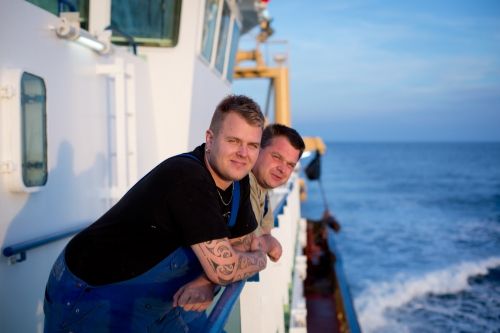Welcome to part 2 of my interview with Leonard Retel Helmrich, co-director of RAW HERRING, the documentary on Dutch herring fishermen that premiered at the 2013 Tribea Film Festival. While part 1 focused on many technical aspects of filming, this section looks mainly at the issues that arise when trying to document human subjects in as revealing a way as possible. I'll briefly add that here, as in part 1, I opted to pare down the actual conversational aspect of our talk, as its Helmrich's insight that should get the attention
Stay tuned for part 3.
Stay tuned for part 3.
On capturing the interaction of members of the crew
I shot about 300 hours altogether. I tried to record as much as possible. These people were made camera aware by the boat company who had said to them ‘behave and be careful, don’t say too much.’
They’d said it on the 1st trip already. i noticed it also that they were behaving differently than any other person who was in front of my camera. And it was only on the 3rd trip that one of the crew members confessed to me they were told to behave. And that’s horrible of course. I knew for sure because now i had proof. But the good thing is they didn’t say that to the children. So the children could ask anything and be themselves. So I just decided to shoot more from the point of view of the children.
Sometimes of course, because people cannot always be ‘not themselves,’ sometimes I managed to catch some moments of them being themselves. Especially in the interaction with each other. Especially when they’re teasing this one guy all the time called Jaap.
On maintaining an objective observer’s stance
It's a conscience decision. I never want interaction between me and the characters. Physically I mean. Because It could happen that they look at me. I never hold the camera in front of myself. So you could look at me, but for the audience you are not talking to the camera. Actually you are, you’re talking to the person holding the camera but the audience doesn’t see that. That’s the same thing as cutting out the question in the interview because the questions are often not relevant to the message you want to come through. And for me the drama and emotion is most important, the interaction of people. And me being there is not relevant for their emotion. And they (should) behave the same whether I’m there with or without the camera. There were only a few moments that they were very much aware when they were talking about things they didn't want me to know actually. And when i was still there and I took out the camera then they stopped talking about it. That’s because they were told by the fishing company ‘behave and don’t be too open.’
Interacting with the crew when not filming
It was quite the same when the camera was off. But they were also very close. And they were Not really cooperative with me. Except for the main characters like the captain, who was a very nice guy, I like him very much. And he was not the one who was dumping the fish at the end. That was another captain. I didn’t want people to think that was the same captain.
I did shoot some things out of sequence this time. I’m not really a fan of chronologically. But if you don’t do it chronologically, the story should be more dramatic. The problem is when you don’t have drama, because these people were very close, then it’s more difficult to have a non-chronological story. Chronology is actually a logic in itself. If you have a story with emotions you can also relate emotions with other emotions from other periods of time. So that’s why we have a different way of weaving a story together. Because I didn’t have enough emotions from the people themselves and not even with the children, I couldn’t do that. But another thing that’s why I wanted to keep the chronology because it better explains how this is done and maybe you can understand that it is all done in a standard way. So, in other words it’s a tradition, the way they do it. But now this tradition by doing it all the time in that same way, now the tradition itself kills itself. Like if you think by tradition, ‘I fish as much as possible, it’s full, I have enough, I’ll dump it...’ Then, next time you have to go up higher north until you can’t go up any higher. So that’s also what I wanted to explain in this way. That following this tradition can sometimes kill your own source of income. That’s the most important reason I thought I would do that. I liked also the way that Grierson had done the same thing, also with a chronology. I thought ok let’s do that in his tradition also, then in this way it really is a followup to Grierson’s film.
Part 3,on the culture of the unique fishing community of Katwijk,coming soon.


No comments:
Post a Comment